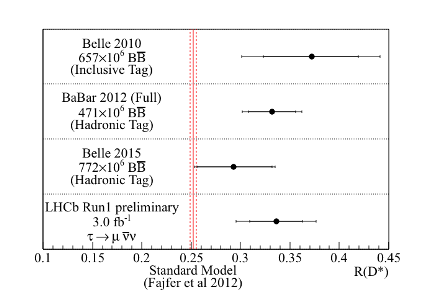Measurement of the decay B0 → D*+τ– ντ
[ Branching fraction ratio B0 → D*+τ– ντ/ B0 → D*+μ– νμ = 0.336±0.027±0.030 ]
Today, at the 13th Flavor Physics and CP violation conference in Nagoya (Japan), the LHCb collaboration presented the preliminary result from a measurement of the branching fraction ratio R(D*): B0 → D*+τ– ντ/ B0 → D*+μ– νμ. The result 0.336±0.027±0.030 is larger than the Standard Model (SM) expectation of 0.252±0.003 by 2.1 standard deviation (σ).
In the SM all charged leptons, such as taus (τ) or muons (μ), interact in an identical fashion (or, in physicists’ language, have the same “couplings”). This property is called “lepton universality”. However, differences in mass between the leptons must be accounted for, and affect decays involving these particles. The τ lepton is much heavier than the μ lepton and therefore the SM prediction for the ratio R(D*) is substantially smaller than 1. This ratio is considered to be precisely calculable thanks to the cancellation of uncertainties associated with the B to D* meson transition.
Any measurement exhibiting a conclusive breakdown of lepton universality, after mass related effects are accounted for, would be a clear sign of new physics. The ratio R(D*) is particularly interesting since a large class of SM extensions contain new interactions that involve third generation of quarks and leptons, like here a b quark (from a B hadron) and τ– and ντ leptons. In particular, the presence of additional charged Higgs bosons, which are often required in these models, can have a large effect.
The image shows a comparison of different results for R(D*). Already a previous measurement from the BaBar collaboration was found to be 2.7σ above the SM prediction. Therefore, the particle physics community has been eagerly awaiting new results. The LHCb measurement confirms the behaviour seen by BaBar. A new measurement from the Belle collaboration, (marked “Hadronic tag”) also presented at Nagoya, lies closer to the SM, but is also consistent with the BaBar and LHCb measurements. An older, less precise measurement by Belle (marked “Inclusive tag”) is compatible with the same picture.
Taken together these results constitute an intriguing anomaly, and one that is sure to provoke much discussion. Future measurements from LHCb with the run-1 data set, and the data sample to be collected in run 2, will allow for the precision on R(D*) to be improved further. The R(D*) anomaly takes its place alongside the RK puzzle (3 June 2014 news) in hinting that the SM assumption of lepton universality may be incorrect.
The LHCb R(D*) measurement is the first measurement of this quantity at a hadron collider and also represents the first measurement of any decay of a B meson into a τ lepton at a hadron collider.
Click the image for higher resolution. Read more in the LHCb presentation at Nagoya, in the LHCb publication, in the Scientific American news, in the Nature news, in the Nature Research Highlights and in the Guardian blog.

